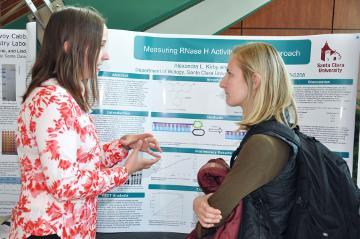
Measuring RNase H Activity: A FRET Approach
Alexandra Kirby
Faculty Mentor: Ángel Islas
Ribonuclease H (RNase H) specifically cleaves RNA in an RNA/ DNA heteroduplex. Human Immunodeficiency Virus-1 (HIV) is a retrovirus that stores its genetic information in two RNA strands. Using an enzyme called reverse transcriptase (RT), HIV RNA is converted to DNA. This process occurs because RT is able to template jump from one RNA strand to another to complete synthesis of viral DNA. RT has an RNase H domain, which is crucial for template jumping as it degrades the RNA, allowing the RT to continue transcription. Inhibiting RNase H activity would block the template jumping process and ultimately prevent the integration of HIV DNA into the host. This research utilizes fluorescence resonance energy transfer (FRET) and an RNA/DNA hybrid to measure RNase H activity. As RNase H cleaves the RNA segment of the hybrid, fluorescein is released and the resulting fluorescence can be detected. The fluorescence generated by the cleavage of fluorescein positively correlates to RNase H activity. FRET assays using E. coli RNase H have demonstrated a positive linear trend of fluorescence generation over time, and preliminary RNase H activities at different concentrations have been ascertained. These activities can be compared against the activity of HIV RNase H. Further assays will be executed to obtain E. coli RNase H activity at other concentrations. HIV RNase H will then be integrated in this assay in order to determine its activity. Once the activity of HIV RNase H is determined, studies to inhibit RNase H activity may be executed.